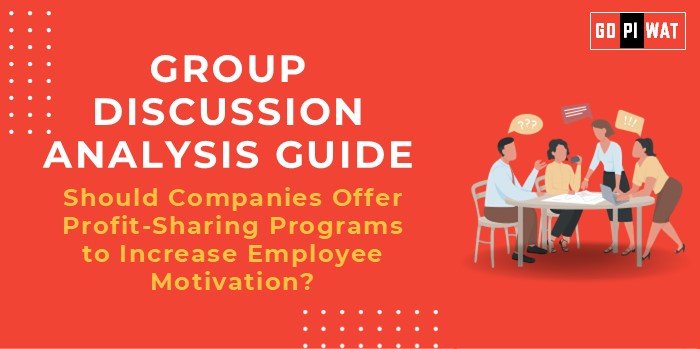📋 Group Discussion (GD) Analysis Guide: Should Companies Offer Profit-Sharing Programs to Increase Employee Motivation?
🌐 Introduction to Profit-Sharing Programs
- 💡 Opening Context: Employee motivation is a cornerstone of organizational productivity, and profit-sharing has emerged as a strategy to align individual performance with company goals.
- 📖 Topic Background: Profit-sharing programs involve distributing a portion of a company’s profits among its employees, fostering a sense of ownership. This idea gained traction in the 20th century as a tool for enhancing loyalty and performance. Globally, companies like John Lewis Partnership (UK) and Infosys (India) have implemented such initiatives.
📊 Quick Facts and Key Statistics
- 🌟 John Lewis Partnership: 67,000 employees benefit from annual profit-sharing, contributing to high retention rates.
- 📈 Infosys (India): Employees receiving profit-sharing bonuses saw a 20% rise in job satisfaction (2022, Company Report).
- 📊 Gallup Report (2023): 74% of employees are more engaged when they share in company profits.
- 💰 ESOP Growth in India: ₹50,000 crore worth of Employee Stock Options were issued in 2023, reflecting the trend’s rise in Indian startups.
🤝 Stakeholders and Their Roles
- 🏢 Employers: Implement and sustain profit-sharing plans to balance profitability and motivation.
- 👩💻 Employees: Their performance directly impacts company profit and shared rewards.
- 📈 Shareholders: Monitor the financial implications of sharing profits with employees.
- 🏛️ Regulators: Ensure legal compliance of incentive and tax structures.
🏆 Achievements and Challenges
✨ Achievements:
- 📈 Improved Employee Morale: Companies implementing profit-sharing report a 15-25% increase in motivation levels (Deloitte, 2023).
- 🔄 Reduced Turnover Rates: Firms like Tata Steel reduced employee attrition by 18% post-profit-sharing adoption.
- ⚡ Increased Productivity: Aligning employee rewards with profits leads to enhanced commitment and productivity.
⚠️ Challenges:
- 💸 Financial Viability: During downturns, sharing profits may stress finances.
- ⚖️ Perceived Inequality: High earners may benefit disproportionately.
- ⏳ Short-Term Focus: Employees may prioritize quick wins over long-term sustainability.
🌍 Global Comparisons:
- 🇺🇸 USA: Companies like Costco show a strong profit-sharing culture, fostering employee loyalty.
- 🇩🇪 Germany: Codetermination laws encourage profit-sharing to maintain industrial harmony.
📚 Case Study:
- 🏢 John Lewis Partnership (UK): Employee-owned model where annual profit-sharing fosters ownership and loyalty.
🗣️ Structured Arguments for Discussion
- ✅ Supporting Stance: “Profit-sharing programs motivate employees by aligning their efforts with company goals, leading to increased productivity and reduced attrition.”
- ❌ Opposing Stance: “Profit-sharing can lead to financial strain during downturns and may create divisions among employees over perceived inequalities.”
- ⚖️ Balanced Perspective: “While profit-sharing programs improve morale and loyalty, companies must design sustainable models that reward performance without compromising financial stability.”
💡 Effective Discussion Approaches
📜 Opening Approaches:
- “Gallup reports that 74% of employees are more engaged when they share company profits, proving its motivational impact.”
- “John Lewis Partnership’s annual profit-sharing has successfully retained employees while boosting company growth.”
🔍 Counter-Argument Handling:
- Argument: “Profit-sharing is unsustainable during economic downturns.”
- Response: “Companies can adopt hybrid models combining fixed salaries with performance-linked bonuses to balance risks.”
📈 Strategic Analysis of Strengths and Weaknesses
- 🏅 Strengths: Enhances motivation and loyalty; encourages goal alignment.
- ⚠️ Weaknesses: Strains company finances during downturns; risk of inequitable distribution.
- 💡 Opportunities: Implement performance-linked profit-sharing; explore hybrid compensation models.
- ⚡ Threats: Market fluctuations impacting profitability; potential resentment among underperforming employees.
🎓 Connecting with B-School Applications
- 📚 Real-World Applications: Profit-sharing programs can be linked to HR case studies, financial sustainability projects, and discussions on employee retention strategies.
- 💬 Sample Interview Questions:
- “How can profit-sharing programs drive employee engagement in competitive industries?”
- “What are the challenges of implementing profit-sharing models in startups?”
- 🔑 Insights for B-School Students:
- Understand the role of incentives in human resource management.
- Analyze profit-sharing programs as financial and motivational tools for long-term business growth.


